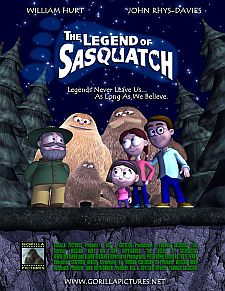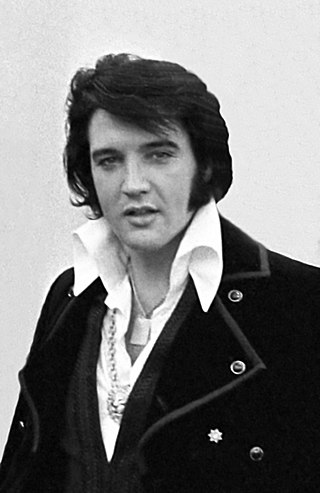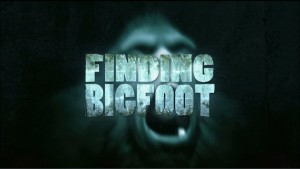
Bigfoot, also commonly referred to as Sasquatch, is a large and hairy human-like mythical creature alleged by some to inhabit forests in North America, particularly in the Pacific Northwest. Bigfoot is featured in both American and Canadian folklore, and since the mid-20th century has grown into a cultural icon, permeating popular culture and becoming the subject of its own distinct subculture.

The Patterson–Gimlin film is an American short motion picture of an unidentified subject that the filmmakers have said was a Bigfoot. The footage was shot in 1967 in Northern California, and has since been subjected to many attempts to authenticate or debunk it.
Grover Sanders Krantz was an American anthropologist and cryptozoologist; he was one of few scientists not only to research Bigfoot, but also to express his belief in the animal's existence. Throughout his professional career, Krantz authored more than 60 academic articles and 10 books on human evolution, and conducted field research in Europe, China, and Java.
The Skookum cast is a plaster cast showing the imprint of what appears to be a large animal. It was discovered in a muddy wallow near Mount Adams in the southern part of Washington state in the year 2000. Enthusiasts have argued that the imprint have been made by the mythical creature, Bigfoot, though scientific analysis says it was most likely an imprint of an elk. Scholars and academics consider Bigfoot, and alleged evidence, to be a combination of folklore, misidentification, and hoax rather than a living animal.
John Willison Green was a Canadian journalist and a leading researcher of the Bigfoot phenomenon. He was a graduate of both the University of British Columbia and Columbia University and compiled a database of more than 3,000 sighting and track reports.
Loren Coleman is an American cryptozoologist who has written over 40 books on a number of topics, including the pseudoscience and subculture of cryptozoology.

Bossburg is a ghost town in Stevens County, Washington, and is located on the east bank of the Columbia River just south of the Canada–US border. Bossburg had a maximum population of 800 in 1892. The town was once named "Young America," although in 1896 it was renamed in honor of the town's first citizen, C. S. Boss. It is currently best known for the 1969 discovery of the footprints in the snow of a supposed Sasquatch known as "Cripplefoot," and subsequent hi-jinks.

Spirit photography is a type of photography whose primary goal is to capture images of ghosts and other spiritual entities, especially in ghost hunting. It dates back to the late 19th century. The end of the American Civil War and the mid-19th Century Spiritualism movement contributed greatly to the popularity of spirit photography. Photographers such as William Mumler and William Hope ran thriving businesses taking photos of people with their supposed dead relatives. Both were shown to be frauds, but "true believers", such as Sir Arthur Conan Doyle, refused to accept the evidence as proof of a hoax.
Bigfoot is an alleged human or ape-like cryptid in North America. Since the mid-20th century, Bigfoot has become increasingly relevant in popular culture and is the subject of film, television, advertising, music, literature and more.

The Legend of Sasquatch is a 2006 American animated adventure film released by Gorilla Pictures that stars William Hurt and John Rhys-Davies. It was released on September 12, 2006 and was the first computer-animated film released by Gorilla Pictures.

Sightings of the American singer Elvis Presley have been reported following his death in 1977. The conspiracy theory that Elvis did not die and instead went into hiding was popularized by Gail Brewer-Giorgio and other authors.

Finding Bigfoot is an American reality television series that aired on Animal Planet. The program followed four researchers including a field biologist (Holland) and explorers investigating potential evidence of Bigfoot, a cryptid hominid living in the wildernesses of the United States and Canada. While the Finding Bigfoot team never captured photographic evidence of the creature's existence, the show gained high ratings and was a top earner for Animal Planet. It premiered on May 29, 2011, and the series finale and 100th episode was released on May 27, 2018. With one special episode released in 2021.
The Jacko hoax was a Canadian newspaper story about a gorilla supposedly caught near Yale, British Columbia in 1884. The story, titled "What is it?, A strange creature captured above Yale. A British Columbia Gorilla", appeared in the British Columbia newspaper the Daily Colonist on July 4, 1884. The original newspaper article describes "Jacko" as a gorilla and not a Sasquatch. However, the "Jacko" story has been used by Bigfoot advocates as evidence for the existence of Sasquatch. Many books about Bigfoot and cryptids have featured the event and cite the original newspaper article. In 2008 Michael Cremo discussed the story as possible proof for the existence of Sasquatch. The "Jacko" story was featured on the A&E television documentary series Ancient Mysteries about Bigfoot, season 4, episode 18 narrated by Leonard Nimoy. The story was also mentioned on the Bigfoot episode of the television series In Search of..., season 1, episode 5, also narrated by Nimoy. The Jacko story was mentioned in a 1976 documentary called The Mysterious Monsters.
Bigfoot is a 2009 American comedy adventure film directed by Kevin S. Tenney with a screenplay by Sandy Schklair. The film stars Richard Tyson, Angie Everhart, Adam Racque, Nicole Badaan, and Kenyon Dudley. It was released on October 6, 2009.
Omar El Akkad is an Egyptian-Canadian novelist and journalist, whose novel What Strange Paradise was the winner of the 2021 Giller Prize.

Spaceman of Bohemia is a science fiction novel written by Jaroslav Kalfař in 2017.

Matthew L. Fraser, also known as Matt Fraser, is an American psychic medium, published author, and television personality. He is best known for his central role in the reality TV show Meet the Frasers. He has three written books including the We Never Die: Secrets of the Afterlife.
Sasquatch is an American true crime documentary television series that premiered on Hulu on April 20, 2021, with a South by Southwest pre-release screen on March 16, 2021. The show begins with investigative journalist David Holthouse's recalling a story he heard in 1993 on a cannabis farm in Mendocino County, part of the Emerald Triangle in Northern California. Holthouse heard someone say that Bigfoot has killed three people on a nearby cannabis farm. Throughout the show Holthouse talks with marijuana growers and law enforcement in Mendocino County, who tell him about possible connections to the Hells Angels biker gang and Spy Rock Road, a lawless marijuana growing area of Mendocino County near Laytonville. These interviews reveal the larger problem of missing persons in the Emerald Triangle.
Mickey7 is a 2022 science fiction book by Edward Ashton. The story follows a space explorer, Mickey Barnes, aka Mickey7, as he is on his seventh cloned iteration, surviving on a beachhead installation on an alien world. A sequel, Antimatter Blues, was released in March 2023.








